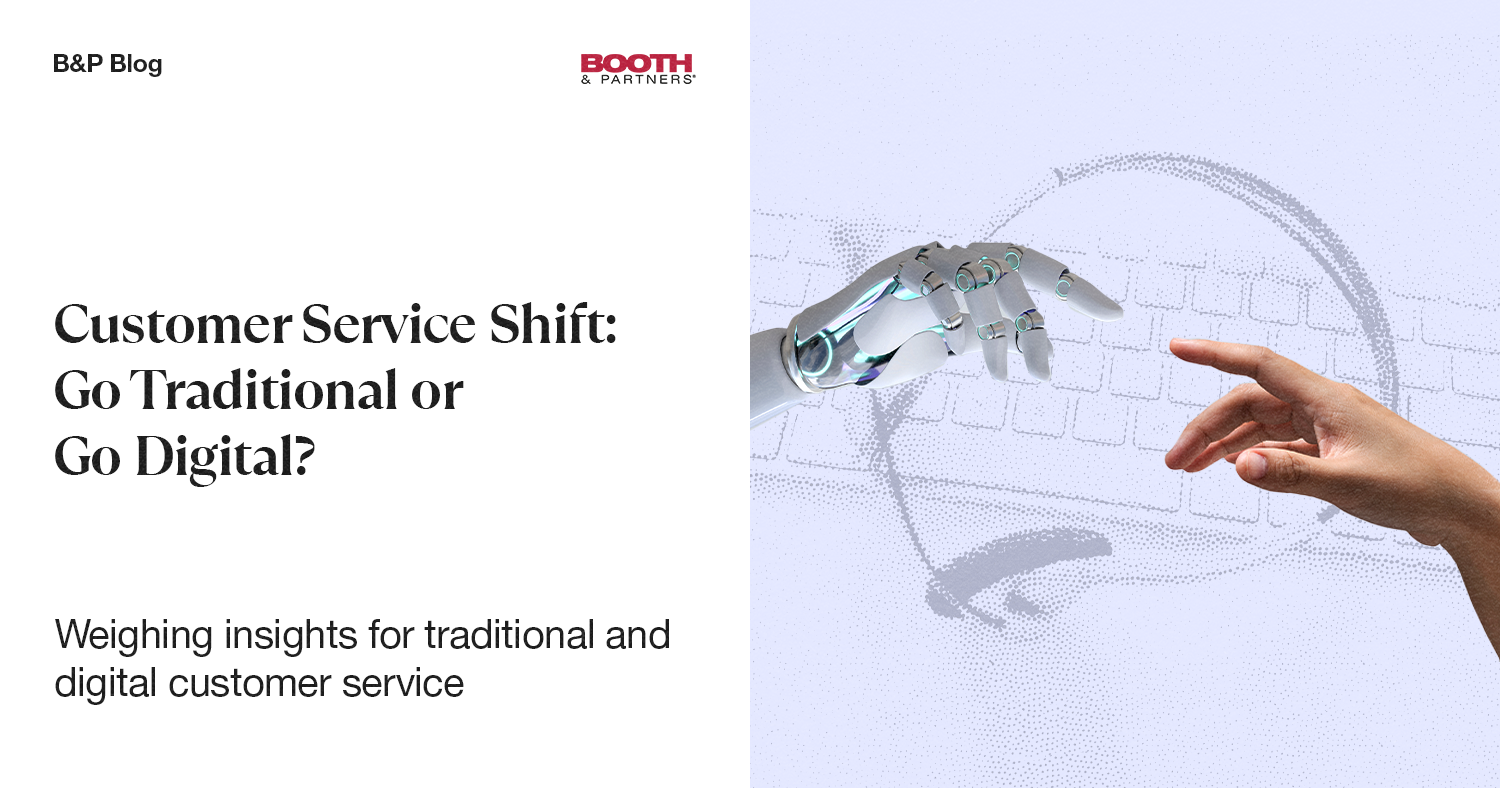Customer Service Shift: Go Traditional or Go Digital?

Customer service is at the forefront of building strong relationships with clients. As companies navigate the intricate balance between tradition and digital advancements, they face a critical decision: should they stick to traditional customer service methods or embrace the digital age?
Let’s explore the shift in customer service approaches, weighing the strengths and weaknesses of both traditional and digital methods.
The Evolving Landscape of Customer Service
Over the years, customer service has come a long way, evolving alongside advancements in technology. Traditional customer service methods, such as phone calls and face-to-face interactions, have long been the backbone of customer satisfaction. However, the rise of digital platforms has offered new opportunities for businesses to connect with their customers. With the increasing prevalence of chatbots, virtual assistants, and social media interactions, companies can now reach their clientele in ways previously unimaginable.
Traditional Customer Service Methods
Traditional customer service methods have stood the test of time, providing a personal touch and human interaction that many customers still value.
- Phone Calls – offer direct interaction with a representative, allowing customers to address their concerns and receive immediate assistance.
- Face-to-Face Interactions – In brick-and-mortar stores, face-to-face interactions provide a unique opportunity for businesses to engage with customers on a personal level.
Drawbacks of Traditional Methods
- Long Wait Times – extended wait times on phone calls can lead to frustration and inconvenience for customers.
- Physical Store Visits – The need for customers to physically visit a store can be inconvenient for some, despite the personalized assistance it offers.
- Efficiency Challenges – Traditional methods may not be as efficient as digital options when handling large volumes of customer inquiries.
Pros and Cons of Traditional Customer Service
Traditional customer service methods have several advantages. They offer a personal touch, allowing businesses to build rapport and trust with their customers. This can lead to increased customer loyalty and repeat business. Traditional methods also provide an opportunity for businesses to showcase their expertise and provide tailored solutions to customer problems.
On the other hand, traditional customer service methods can be time-consuming and costly. Hiring and training customer service representatives, managing call centers, and maintaining physical store locations all require significant resources. Moreover, traditional methods may not be as accessible or convenient for customers in today’s fast-paced, digital world.
Digital Customer Service Methods
As technology continues to reshape the way businesses interact with their customers, digital customer service methods have emerged as essential tools for providing timely and effective support. From automated chat systems to self-service portals, these methods are redefining the customer service experience.
- Chatbots and Virtual Assistants – provide instant responses to customer inquiries, offering 24/7 support without human intervention. While efficient, they may lack the personal touch of human interactions, potentially impacting the overall customer experience.
- Social Media Platforms – enable real-time connection with customers but require careful handling of public interactions to maintain a positive brand image and customer relationships.
- Email Support – provides a formal channel for issue resolution and customer inquiries, allowing detailed and documented exchanges to address complex or sensitive customer issues.
- Self-Service Portals – empower customers to find answers independently, reducing the volume of inquiries requiring direct customer service intervention. They enhance customer satisfaction and free up resources for handling more complex issues.
- Video Chat Support – offers a more personal touch, allowing for visual demonstrations or troubleshooting assistance. This enhances the customer support experience by providing a more engaging platform for issue resolution.
Pros and Cons of Digital Customer Service
Digital customer service methods offer several benefits, providing businesses with new opportunities to enhance customer interactions. Below are the pros and cons of digital customer service:
Pros
- Instant Responses – Digital customer service provides instant responses and support, allowing businesses to address customer inquiries in a timely manner.
- Cost-Effective – Digital methods require fewer resources compared to traditional methods, making them cost-effective for businesses.
- Data and Insights – Digital platforms provide a wealth of data and insights that businesses can leverage to improve their customer service strategies.
Cons
- Impersonal – Digital remote customer service methods can be impersonal and may not meet the needs of all customers who prefer personalized interactions.
- Technological Demands – Staying up-to-date with the latest technologies and platforms is required for digital methods, which can be challenging and time-consuming for businesses.
The Importance of Omnichannel Customer Service
With the increasing reliance on technology, businesses must adapt to meet changing consumer expectations and preferences. Customers want quick and seamless support. This is where digital customer service and omnichannel customer support come into play.
Omnichannel customer service involves integrating traditional and digital methods to provide a cohesive and consistent customer experience. By adopting an omnichannel approach, businesses can leverage the strengths of both traditional and digital customer service methods. This allows you to cater to a wider range of customer preferences and needs. For example, customers can choose to interact with a business via phone, email, social media, or in person, depending on their preferences and the nature of their inquiry.
From chatbots and virtual assistants to self-service portals and social media platforms, companies are leveraging technology to enhance the customer experience across multiple channels. By incorporating artificial intelligence and automation, businesses can provide round-the-clock support and resolve queries in real time.
But it’s not just about automation. The human touch remains essential in customer service. Companies must strike the right balance between technology and human interaction to provide a personalized experience. Responsive and empathetic customer service agents will always be crucial in building strong relationships and fostering customer loyalty.
Integrating Traditional and Digital Customer Service
Finding the right balance between traditional and digital customer service methods is crucial for businesses looking to provide exceptional customer experiences. Instead of choosing one over the other, businesses should aim to integrate both methods seamlessly.
For example, businesses can offer self-service options online, such as chatbots and FAQ sections, while still providing the option for customers to speak with a live representative if needed. This way, customers have the flexibility to choose the most convenient and efficient method for their specific inquiry.
Tools and Technologies for Efficient Customer Service
To make the most of traditional and digital customer service methods, businesses can leverage various tools and technologies such as the following:
- Customer Relationship Management (CRM) Software – helps track and manage customer interactions across channels, enabling personalized and efficient customer service.
- Data Analytics – provides insights into customer preferences and informs decision-making for improved customer service strategies.
- Live Chat and Chatbots – offer real-time customer support and automate responses to FAQs, enhancing response times.
- Social Media Management Tools – facilitates engagement and support on social media platforms, and allows for monitoring and responding to customer inquiries and feedback in a timely manner.
- Ticketing Systems – helps in organizing and prioritizing customer inquiries and issues and enables efficient tracking and resolution of customer issues.
- Knowledge Base and Self-Service Portals – empower customers to find answers to common questions independently and reduce the workload on customer support teams by providing self-service options
Measuring Customer Service Success
Measuring the success of customer service efforts is essential for businesses to understand how well they are meeting customer expectations. Key performance indicators (KPIs), such as customer satisfaction scores, response times, and resolution rates, can provide valuable insights into the effectiveness of customer service strategies.
By regularly monitoring and analyzing these metrics, businesses can identify areas for improvement and make data-driven decisions to enhance the overall customer experience.
Finding the Right Balance
With the digital shift, businesses have the opportunity to reimagine customer service and deliver unparalleled experiences. While traditional customer service methods offer a personal touch and human interaction, digital methods provide convenience and efficiency. Striking the right balance between the two is crucial for businesses to meet customer expectations and build strong relationships.
By embracing this change and learning how to blend the best of traditional and digital customer service methods, companies can stay ahead of the curve and create lasting connections with their customers. The key lies in understanding customer preferences, staying adaptable to changing trends, and continuously evolving to meet the needs of a diverse customer base.
Let’s work together to find the right balance and make a lasting impact on your customers. Contact us today.
Discover more about outsourcing and
how you can maximize it for your
business success!
Get a copy of our E-book: Guide to Outsourcing.




